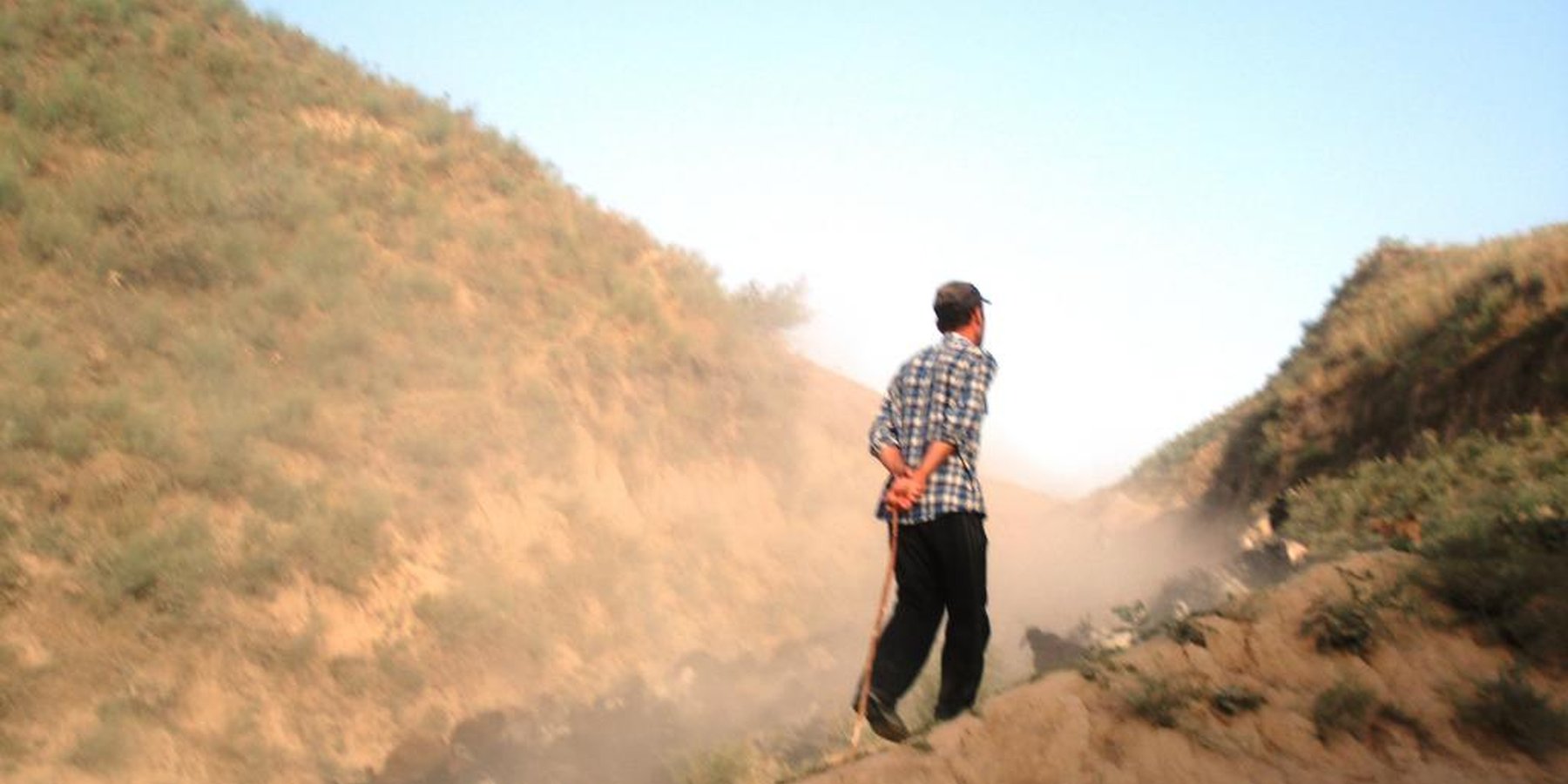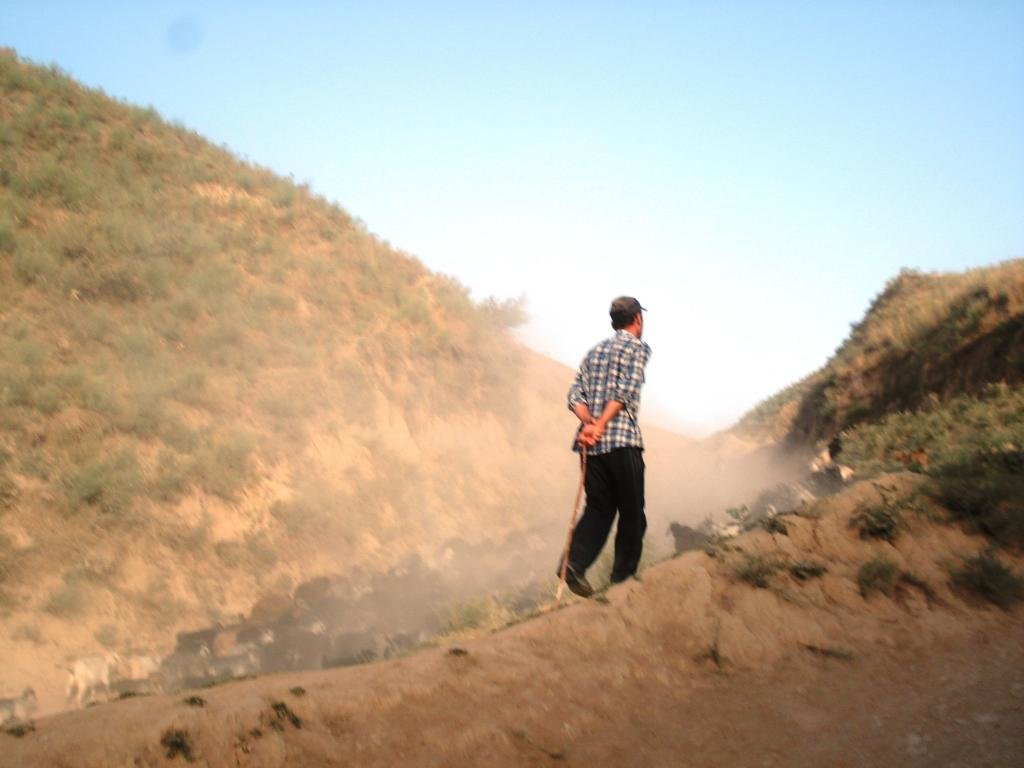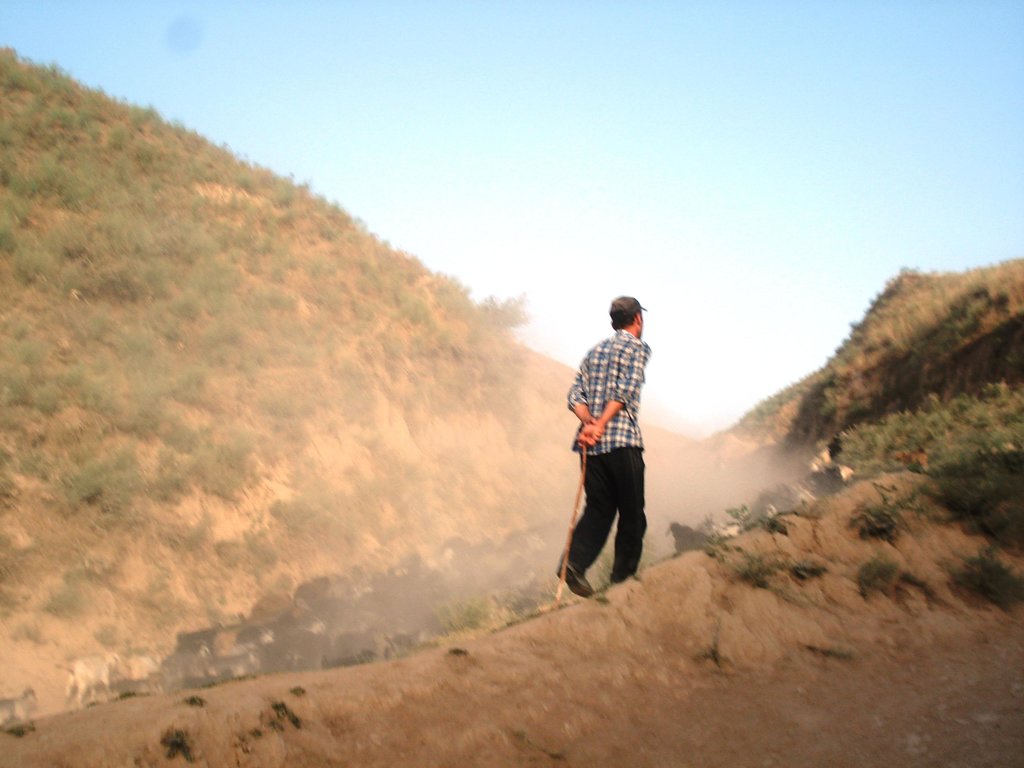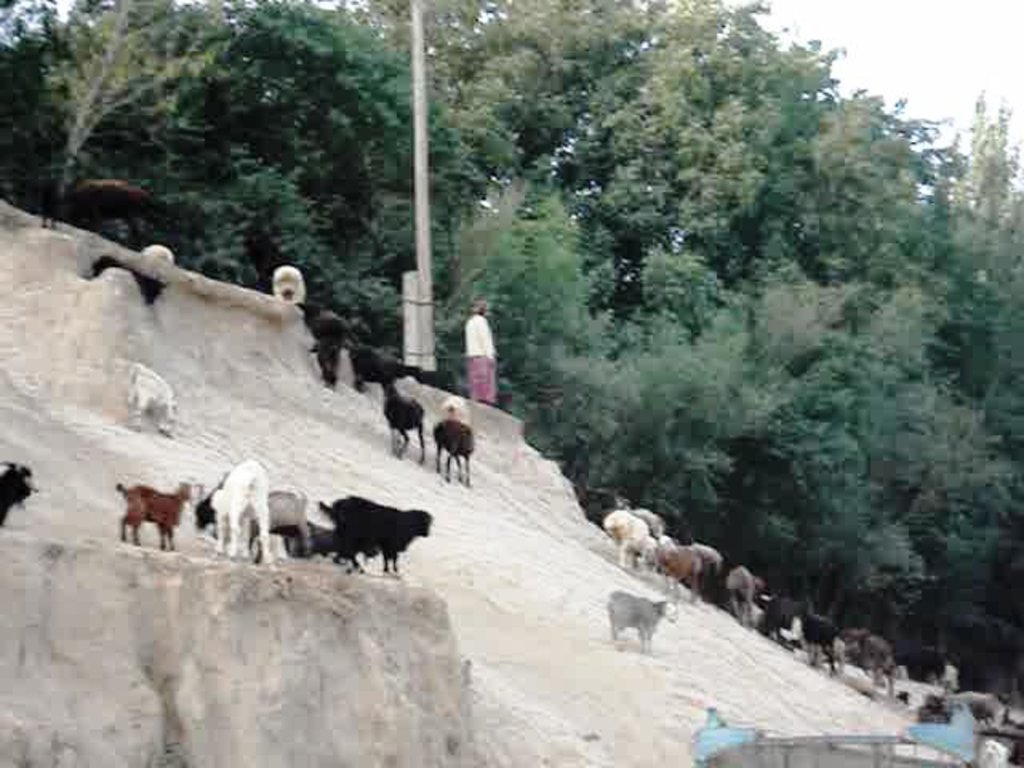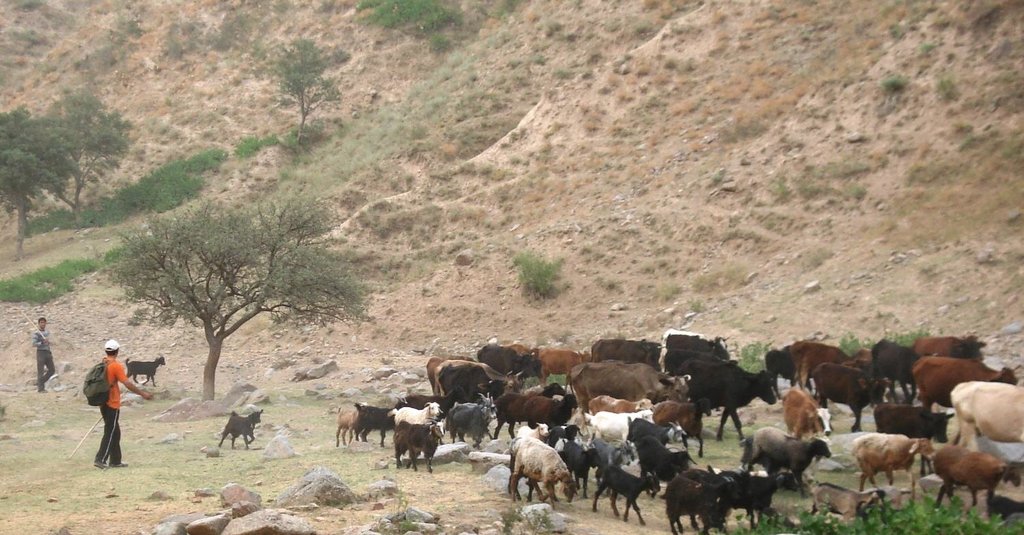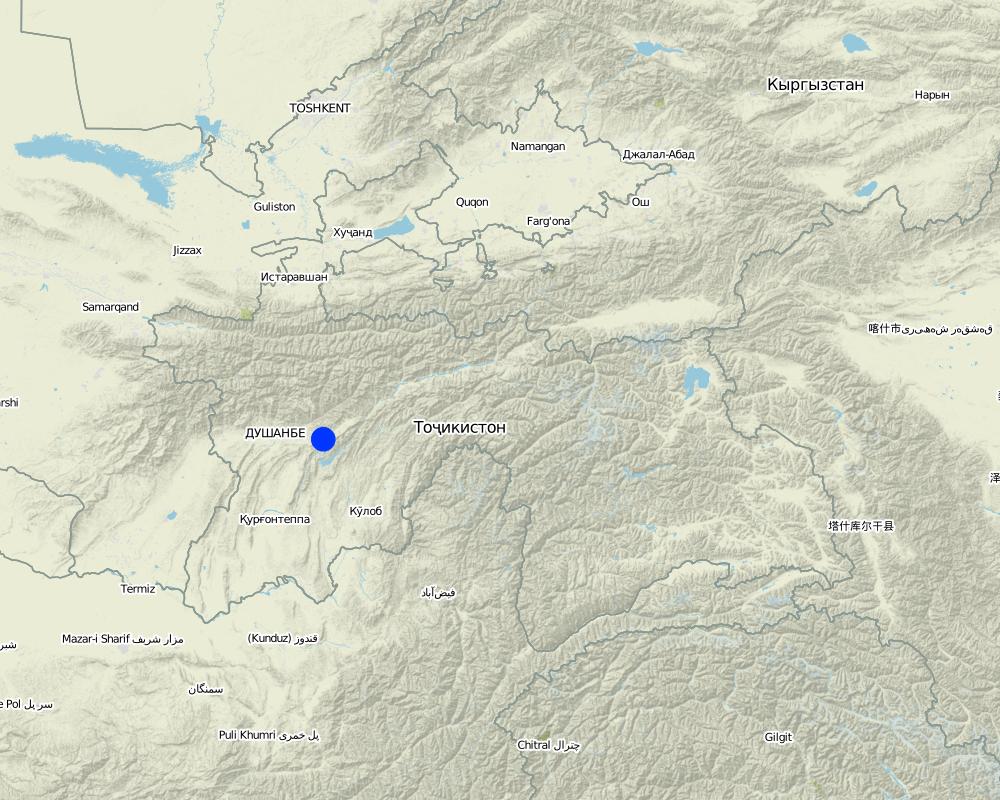Common village herding [塔吉克斯坦]
- 创建:
- 更新:
- 编制者: Christian Wirz
- 编辑者: –
- 审查者: David Streiff
Navbati Poda (succession of herders)
approaches_2656 - 塔吉克斯坦
查看章节
全部展开 全部收起1. 一般信息
1.2 参与方法评估和文件编制的资源人员和机构的联系方式
有助于对方法进行记录/评估的机构名称(如相关)
CDE Centre for Development and Environment (CDE Centre for Development and Environment) - 瑞士1.3 关于使用通过WOCAT记录的数据的条件
(现场)数据是什么时候汇编的?:
15/08/2008
编制者和关键资源人员接受有关使用通过WOCAT记录数据的条件。:
是
1.4 SLM技术问卷的参考
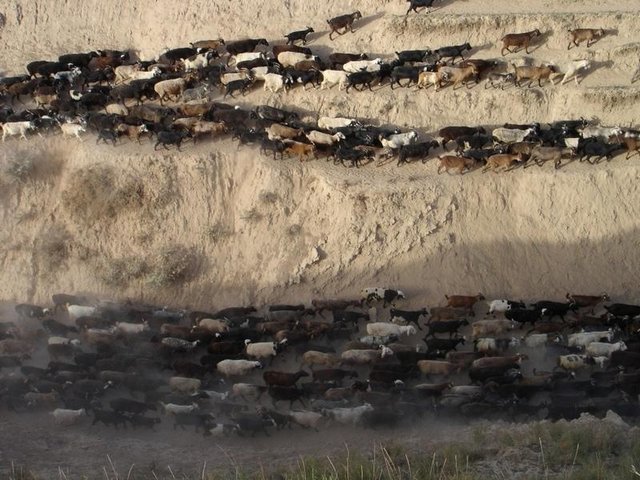
Daily grazing of village-herds [塔吉克斯坦]
Rotational grazing on village pastures with heavy pressure with daily to weekly change of grazing places.
- 编制者: Christian Wirz
2. SLM方法的描述
2.1 该方法的简要说明
Village herding system with daily alternation of the herders including each household in a monthly turnus.
2.2 该方法的详细说明
该方法的详细说明:
Aims / objectives: The herding system has to be easy and little labour-intensive, because children are the main workforce. It is a collective system and thus requires the participation of all households with families: For instance in the village Karsang with 141 households (not all having livestock) and two village herds, each family has to send monthly one child for herding or pay if it does not have workforce. In addition, always at least one adult has to accompany the herd. This means that children of big families only rarely miss school whereas those from small families miss more frequently. The final objective is to nourish animals maximally so they need a minimum of costly hay and concentrated feed (in terms of labour respectively in financial terms).
Methods: Children and adults are taught by the elders, the parents and the village land use committee how the rotation works: They should not stay at one place longer than three days, they should not chase the animals which otherwise lose energy unnecessarily and they shall not lose animals. Children not obeying are punished. In case of lost animals different approaches exist: Mostly the family of the herder who was responsible for the herd on the respective day reaches an agreement with the tenant's family.The village committee or elders can also arbitrate.
Stages of implementation: It is difficult to say when this system first emerged. A land user says that during Soviet Union there were village herds with a fix herder or an alternation like nowadays and, parallely, wealthy people had their own herd with a paid herder. During civil war only a few rich villagers kept animals and only at the beginning of the 2000s collective herding reemerged.
Role of stakeholders: The implementation of herding is a matter of each family's participation. The collaboration of the villagers with institutions is especially important in questions of taxes. In most villages the households pay per capita animal taxes. In order to improve SLM the land use committee on district level and the forest administration (as far as the village has such pastures) together with the local representants of the ecology commission advise the land use committees of each village to take the appropriate measures. And these talk with the herders to influence their comportment. A teacher from the local land use committee says that a lot is said about SLM, but little is effectively done.
2.3 该方法的照片
2.5 采用该方法的国家/地区/地点
国家:
塔吉克斯坦
区域/州/省:
Region of Republican Subordination
有关地点的进一步说明:
Faizabad
Map
×2.6 该方法的开始和终止日期
注明开始年份:
1920
2.7 方法的类型
- 传统/本土
2.8 该方法的主要目的/目标
The Approach focused mainly on other activities than SLM (Maximal nutrition of livestock with child labour.)
In animal husbandry the semi-monetary value of livestock is important. Therefore, 'everyone would like to have more animals', says a land user. At the same time agricultural population has other activities such as the cultivation of kitchen-gardens and of cropland. And labour shortage is omnipresent, with many young men staying in Russia for work. In these multistrategies efforts for herding must be minimised which is best possible if children are sent as herders.
The SLM Approach addressed the following problems: The approach needed and needs to be compatible with the traditionally sedentary culture and with the new employment and income sources in local economy: be it the work as a taxi-driver or selling vegetables on the local market. Today herding has to be especially cheap (finance, labour) because there is a multitude of preferences how to invest resources: building a (better) house, buying a mobile phone and a car or enabling (higher) education of children.
2.9 推动或妨碍实施本办法所适用的技术的条件
财务资源和服务的可用性/可得性
- 阻碍
Keeping animals is expensive because you have to nourish them (see costs of technology).
Treatment through the SLM Approach: The use of comparatively cheap grazing land of the former collective farms that is under village administration and contracts with forest administration for cheaper land are the solution.
机构设置
- 阻碍
If the defined herding system is not respected, cover is damaged, especially trees. And institutions have little authority in implementation, partly because of their own corruption.
Treatment through the SLM Approach: Implementation is based on the households: They do not only send their children for herding, but they also punish them if they treat animals badly.
法律框架(土地使用权、土地和水使用权)
- 启动
The existing land ownership, land use rights / water rights moderately helped the approach implementation: The fact that a great part of grassland of former collective farms has not yet been attributed to farmers' associations makes it possible for everyone to use them. The only disadvantage in the eyes of land users is that they have to pay rent fees for this land.
工作量、人力资源可用性
- 阻碍
It is difficult to find labour force that is able to walk to the pastures with the animals, because many young men are in Russia.
Treatment through the SLM Approach: Children are cheap and mobile.
3. 相关利益相关者的参与和角色
3.1 该方法涉及的利益相关者及其职责
- 当地土地使用者/当地社区
ny people with animals participate in collective herding. Especially poor families cannot afford professional herding.
There are both boys and girls working as herders. Among adults, men more often working as herders than women.
The role of women is traditionally associated with domestic work and kitchen gardens.
- SLM专家/农业顾问
Different institutions: land use committees, forest administration, committee for ecology.
- 教师/学龄儿童/学生
如果涉及多个利益相关者,请注明领导机构:
Mainly land users supported by SLM specialists
3.2 当地土地使用者/当地社区参与该方法的不同阶段
| 当地土地使用者/当地社区的参与 | 指定参与人员并描述活动 | |
|---|---|---|
| 启动/动机 | 自我动员 | Initiatation and planning was organised among villagers. They based themselves on experiences from Soviet times and from before. |
| 计划 | 无 | |
| 实施 | 互动 | Recently the institutions mentioned have become more important. |
| 监测/评估 | 无 | |
| Research | 无 |
3.4 有关SLM技术选择的决策
具体说明谁有权决定选择要实施的技术:
- 仅限土地使用者(自主)
解释:
Animal husbandry is chosen as an important strategy because it provides for higher levels of self-sufficiency.
Decisions on the method of implementing the SLM Technology were made by mainly by land users supported by SLM specialists. Even if the methods are somehow prescribed by land use committees, herders themselves finally decide on the herding strategy.
4. 技术支持、能力建设和知识管理
4.1 能力建设/培训
是否为土地使用者/其他利益相关者提供培训?:
否
4.2 咨询服务
土地使用者有权使用咨询服务吗?:
否
4.4 监测和评估
监测和评估是该方法的一部分吗?:
是
注释:
bio-physical aspects were regular monitored by other through observations; indicators: Local land use committees go to the pastures in spring to decide whether soils are dry enough and gr
economic / production aspects were ad hoc monitored by land users through observations; indicators: Land users control if their animals are fat and if they give milk. Otherwise they might not send the
There were no changes in the Technology as a result of monitoring and evaluation: None
4.5 研究
研究是该方法的一部分吗?
否
5. 融资和外部物质支持
5.1 该方法中SLM组成部分的年度预算
如果不知道准确的年度预算,请给出一个范围:
- < 2,000
注释(例如主要的资助来源/主要捐助者):
Approach costs were met by the following donors: local government (district, county, municipality, village etc) (Meetings of administration with leaders.): 20.0%; local community / land user(s) (Organising herding: low costs.): 80.0%
5.3 对特定投入的补贴(包括劳动力)
如果土地使用者的劳动力是一项重要的投入,那么是不是:
- 自愿
注释:
Herding is not rewarded by anyone. But if a family does not respect its obligations (monthly sending a herder) it has to pay compensation.
5.4 信用
是否根据SLM活动的方法给予信用值?:
否
6. 影响分析和结论性陈述
6.1 方法的影响
该方法是否帮助土地使用者实施和维护SLM技术?:
- 否
- 是,很少
- 是,中等
- 是,支持力度很大
该方法是否有助于社会和经济弱势群体?:
- 否
- 是,很少
- 是,中等
- 是,支持力度很大
Especially poor population could profit from cheap communal pastures and thus afford keeping livestock.
Did other land users / projects adopt the Approach?
- 否
- 是,很少
- 是,中等
- 是,支持力度很大
It can be assumed that this somehow logical solution of herding for settled people (not like in other Central Asian countries) emerged as a part of self-sufficient strategies during USSR. Similar herding patterns might though have existed already before USSR, according to local experts.
Did the Approach lead to improved livelihoods / human well-being?
- 否
- 是,很少
- 是,中等
- 是,支持力度很大
Compared to a situation without private livestock this is clearly an improvement in terms of
Did the Approach help to alleviate poverty?
- 否
- 是,很少
- 是,中等
- 是,支持力度很大
By increasing self-sufficiency it did contribute to better nutrition of rural households with livestock than of many people in town who have to buy meat (which is expensive).
6.2 土地使用者实施SLM的主要动机
- 增加生产
- well-being and livelihoods improvement
Little SLM is contained in the approach of common herding. But if there is motivation to implement S
6.3 方法活动的可持续性
土地使用者能否维持通过该方法实施的措施(无外部支持的情况下)?:
- 不确定
若否或不确定,请具体说明并予以注释:
On the one hand decreasing productivity of pastures threatens their daily use by big herds. On the other hand the increasing consciousness of leaders about degradation might make herding more expensive (animal taxes) and not affordable for everyone anymore.
6.4 该方法的长处/优点
| 土地使用者眼中的长处/优势/机会 |
|---|
| This form of herding is not conflictive: all people can afford it and everyone contributes to it by sending an own family member for herding. And, if a herder loses a villager's animal, the villager knows that he will also be a herder and might lose an animal, too. (How to sustain/ enhance this strength: The institutions - be it elders or the land committee - must implement the technology.) |
| 编制者或其他关键资源人员认为的长处/优势/机会 |
|---|
| Common herding has a strong social component as it makes herders cooperate in order to maintain reputation (How to sustain/ enhance this strength: Projects in Muminabad proposed by the village with a professional herder elected in a village meeting ) |
6.5 该方法的弱点/缺点以及克服它们的方法
| 土地使用者认为的弱点/缺点/风险 | 如何克服它们? |
|---|---|
| The dependance upon children rather hinders the implementation of SLM, according to some land users. Children prefer to play rather than to respect rules about herding, says for example a teacher. And he adds that also adults do not always respect the established rules and that nobody controls effective implementation of the technology. | It is difficult to find adult herders. One village - Chujamar - decided to engage a professional herder, who would lead the cows to the pastures separately. Because cows cannot be lead only by children like little animals, according to the chief of that village. The villagers pay around 2$ per cow and season for herding. |
| 编制者或其他关键资源人员认为的弱点/缺点/风险 | 如何克服它们? |
|---|---|
| Land users mention that implementation is difficult with herders (often children) that lack the necessary knowledge to implement SLM. | It is difficult to abolish child labour. But, by completing the herders' team with at least one professional, paid herder, progress in SLM would be possible perhaps. And making pastures a subject in school might help to araise awareness about SLM. |
链接和模块
全部展开 全部收起链接

Daily grazing of village-herds [塔吉克斯坦]
Rotational grazing on village pastures with heavy pressure with daily to weekly change of grazing places.
- 编制者: Christian Wirz
模块
无模块


